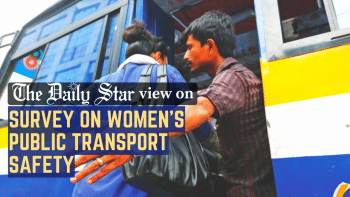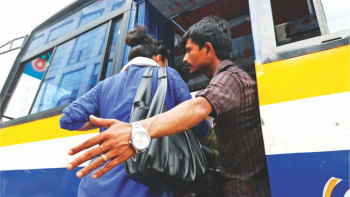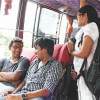How to not ‘be a woman’ on Bangladeshi public buses

Picture this: In late October of last year, it's the night of the Sitrang cyclone. It has been raining in Dhaka city since morning, and in the evening that turns into a storm. I don't feel relieved like I usually do as my time to leave the office draws nearer. But head out I must. Predictably, my go-to bus for Mirpur is nowhere to be seen that night, just as the other public buses which occupy every square foot of the Farmgate intersection. Miraculously, though, armed with my going-going-gone umbrella, I only have to stand on the roadside for a couple of minutes before a bus appears – a single-decker, accordion-style, red BRTC bus carrying (and this will shock you) all women. It won't take me as close to home as I would like, but that will have to do. I rush to the entrance and hop on.
This was also when I first noticed the frustration of the men on the roadside as they realised that this is one bus they cannot board. So much so that, at a later stop, when myself and the other passengers were habitually stopping men from getting on, one man screwed up his face into a half-leer, half-frown and demanded, "Ken? Apnera ki amader bus e uthen na?" ("Why? Do you not use our buses?") Mon dieu, the brother had put me in my place!
Self-soothing sarcasm aside, where is a Bangladeshi woman to go, then, if she is supposedly undeserving even of the place specifically reserved for her?
From what I have observed within the capital at least, most men seem to harbour a negative attitude towards women receiving "special treatment" on public transportation. It starts, of course, with some men acting as if buses having "reserved seats" for women is somehow the same as depriving the former of their human rights. More recently, some buses have also been refusing to let women on if there are no seats available and if they will have to stand during the journey. Much kudos for such performative chivalry, I say!
If only this sentiment was consistent and men didn't loudly express their discontent at women sitting on regular, non-reserved seats. Men's complaints even take them to the point of demanding, "Ai mohila uthais na!" ("Don't let women get on!").
Alas, women's side of reality is even less rosy. The five to nine (depending on the bus' size) reserved seats that male passengers seem to covet are really no prize. They are usually placed on top of the engine, making the seats too hot to sit on comfortably. Moreover, the women's seating area is usually more cramped, with leg space being slim to nil. Then there's the proximity to the driver, who is often no more a gentleman than the male passengers whose gaze (and touch) the reserved seats are supposed to protect women from.
From what I have observed within the capital at least, most men seem to harbour a negative attitude towards women receiving "special treatment" on public transportation. It starts, of course, with some men acting as if buses having "reserved seats" for women is somehow the same as depriving the former of their human rights. More recently, some buses have also been refusing to let women on if there are no seats available and if they will have to stand during the journey. Much kudos for such performative chivalry, I say!
And while I openly admit that women passengers are really not as good at standing on a moving and swerving bus as their male counterparts, one really cannot expect them to be, either. Childhood may be a different story, but starting from puberty, girls are discouraged from being active or agile. Beyond their studies, most are taught to shelter themselves from the male-dominated outside world. As such, even in a country that is half theirs by law, girls and young women grow up practising being as anonymous as possible, so as to avoid commonplace sexual harassment or violence.
So, how can women travel on public transport without feeling like sub-humans?
The most realistic and provenly effective solution is women-only buses. However, they are a sight rarer than a bi-yearly blood moon. The first women-only buses were introduced in the capital in 2010 by the Bangladesh Road Transport Corporation (BRTC). Rangs Motors followed along with their own Dolonchapa buses in 2018. And while the number of these buses plying our roads was never able to meet commuter demands adequately, the situation worsened during the pandemic recovery period.
According to a report by The Business Standard from October 2022, of the original 22 women-only buses from the BRTC, 18 have been phased out for various reasons over the years. The four that remain only operate on four routes. Dolonchapa's plan of expanding from four to 60 women-only buses, too, has not met fruition. Now, the four buses only offer two trips, operating on one single route.
It is unfortunate that what really stands between women and affordable transportation is a lack of profitability. Still, nowadays, the ratio between male and female passengers on any given bus is much closer to being equal than what it used to be even a decade ago. More students and working women now use public transport within the capital, given the mode's affordability.
But the exclusionary "rules" imposed by transport companies – coupled with the deficient supply of public buses themselves – mean that many women, especially during the rush hours, are unable to board a bus even if they want to, and might ultimately decide to use a different, more expensive mode of transport. For them, the rare sighting of a women-only bus is always a welcome blessing. When I boarded that all-women BRTC bus in October, for instance, I felt relieved in equal parts because I had found a ride home during a storm and because I wasn't having to be alert about men standing too close to me and touching me inappropriately. More importantly, I felt that I was occupying my place on a city bus as a dignified and deserving citizen, not as a social pariah who inconvenienced men simply by existing.
As such, a feasible solution might be for our government to subsidise the operation of women-only buses to make up for the alleged low occupancy rate of non-peak hours. This would also bring the country closer to achieving a number of sustainable development goals (SDGs) by 2030, such as Goal 5 (Gender Equality), Goal 10 (Reduce Inequalities), and Goal 11 (Sustainable Cities and Communities).
All things said and done, travelling on public buses is one experience I have never been able to romanticise. It is obvious that women and their mobility are something our society actively opposes (and will continue to oppose for a long time), and that public transport is where this is best exemplified.
But beyond the technicalities of laws, regulations, and The System, my suggestion to women would be to simply take up space. If you can walk, do so briskly and surely, no matter how many men are crowding the footpath that is also rightfully yours. When a man is seated next to you on the bus, don't cower into the corner. Instead, claim your half of the seat (that you are paying for) physically and, if needed, verbally. And when you see a man occupying a seat reserved for you by law, demand that he leaves it. Be coarse when needed. Plant your feet firmly onto the bus floor and try to keep steady against the impractical system given to you. Even having a patriarchal mob practically pressed against you, stand tall and occupy your square foot or so of space.
After all, in the words of womanist writer and activist Audre Lorde, survival "is learning how to stand alone, unpopular and sometimes reviled… to make common cause with those others identified as outside the structures in order to define and seek a world in which we can all flourish."
Afia Jahin is a member of the editorial team at The Daily Star.

 For all latest news, follow The Daily Star's Google News channel.
For all latest news, follow The Daily Star's Google News channel. 






Comments